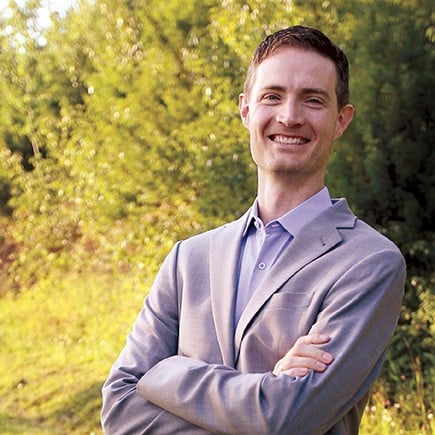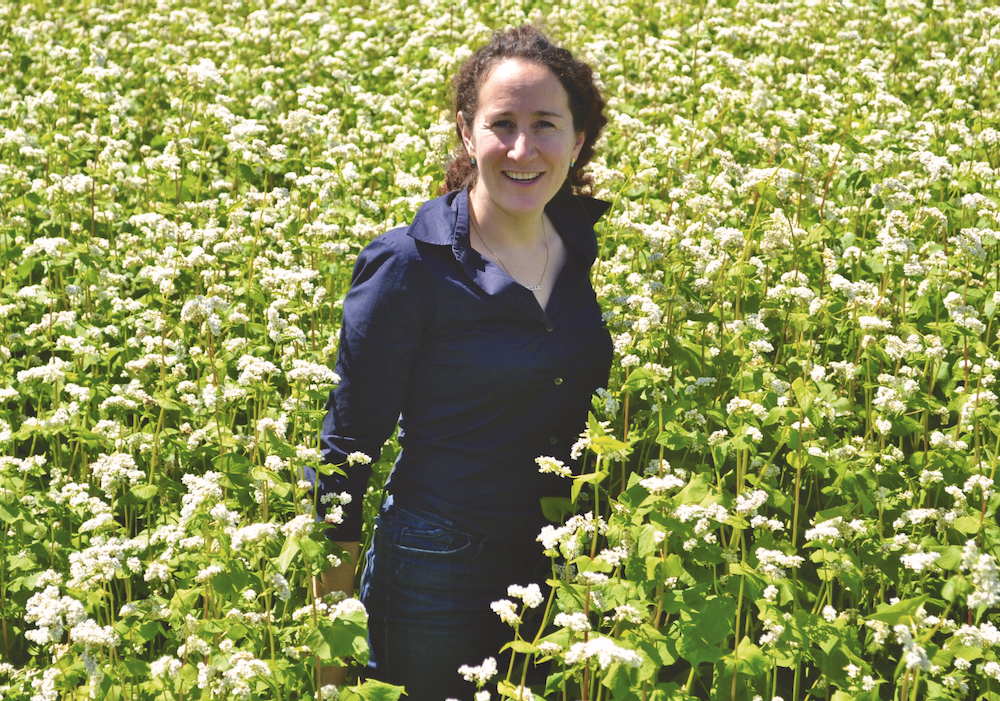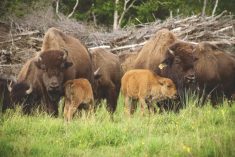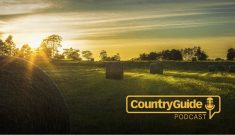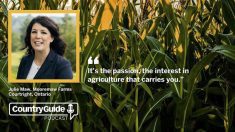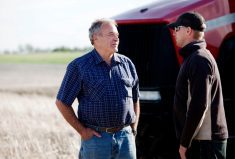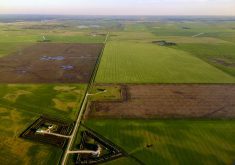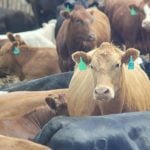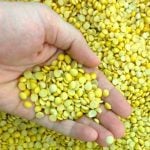No matter where they farm and no matter what they grow or produce, farmers lose sleep over the same questions, because no matter who they are, there aren’t any simple answers. How do you expand? How can you pick the right new technologies and invest in them? And, perhaps the most anxiety producing of them all, what if your children want to come back to the farm? How do you make that happen?
They’re questions that seem like they should have some obvious if not easy answers. Instead, they’re what you might call agriculture’s iceberg issues. The bit you can see is only a hint at what lies under the surface.
So, if you need more acres, someone might say, just rent them, or have a meeting with the bank and throw a few more shovels full of debt onto the pile.
Read Also

What to consider when setting up farm-related business ventures
Things to consider before launching a farm-adjacent side business.
Under the surface, though, are all those questions. Where can you find more land, how can you service more debt, how much longer can you wait?
It can make you wish you didn’t know the challenges so well, because right now it feels like you’re in danger of getting lost in the weeds before you even take your first step.
As agriculture continues to grow in popularity — and let’s face it, it hasn’t been this popular in more than 50 years — it’s clear that many who have no ag background and haven’t ever set foot into a field are increasingly interested in the industry as a business investment. And there may, possibly, be good news in this for farmers, especially those who are leveraged to the hilt yet know that unless a few critical pieces line up for them, they are actually going nowhere. And that potential good news starts with unique models that have sprung up in different areas of the world where investors are funding partnerships on the farm.
If that seems unlikely to you, you aren’t alone, but dig a little deeper and your scepticism may waver. Some of these groups seem to have a good fit, at least on some farms. After all, farmers play a long game; maybe investors do too. And both have an eye out for investment value. With a finite landbase globally, land values continue to ratchet up. Farm Credit Canada reports that since 2012, Canada’s farmland has gone up at least 5.2 per cent annually. In 2022, the national farmland value jumped 12.8 per cent. Ontario led the way with an eye popping 19.4 per cent while B.C. was “last” with an impressive 8 per cent.
With generally favourable long-term market projections that reduce risks while the land investment grows, it seems a smart choice for both.
But is it? Country Guide took a look at one Canadian company bridging the gap between the farm and the city to see if they are really working together like never before.
Area One Farms
Canada
A Canadian-owned business that operates throughout the country, Area One Farms was created by Joelle Faulkner, an Ontario farm girl raised on the family dairy farm near London but who now, because of her success in agriculture, spends her days in downtown Toronto, steps from its famously upscale Leaside neighbourhood
To her, there’s no real disconnect. It’s her farm background, she says, that gives her the knowledge base to work both with investors eager to diversify their portfolios and also with farmers looking for new ways to continue or to grow their farm businesses and their farm way of life.
“Based on our family’s experience, farmland was a good investment, but I actually didn’t like the idea that investors — who were just starting into farmland at the time — would buy land and rent it out,” Faulkner says.
“If the farmer doesn’t participate in any of the appreciation, they’ll never be able to buy the land. What I was looking for was whether you could make a partnership where the farmer always got a disproportionate amount of the appreciation so that eventually they could buy out the investor. And the investor would still do well enough that it would be worth doing.”
It turns out she thinks she can and it’s successfully happening across Canada. With 41 farmers and 180,000 acres of land under the AOF program, business is going well. Most farmer clients are mid-career, between 35 and 55, and while they have farms of various sizes, they have growth on their minds.
Depending on what a farmer is after, AOF offers two models to choose from.
More details are available via its website, but essentially for a crop share, a farmer simply pays a minority amount of money to buy additional land with AOF fronting the majority capital. Faulkner says this is mainly aimed at farms that want to capture smaller growth opportunities or when the land is less than 50 per cent of the farm’s existing base.
The participating farmer pays the operating expenses but gets paid crop revenue minus crop-share rent. The investors, meanwhile, are on the hook for land taxes and a pre-determined amount of crop insurance.
The second offer, AOF’s full farm partnership concept, allows for arguably larger scale growth opportunities and is often used in scenarios where a farming child and spouse are returning to the farm and the farm needs to expand to meet the additional living expenses.
In this case, the farmer contributes the farm, machinery and infrastructure while AOF contributes cash into a partnership. Using that cash, the partnership then buys the land the farmer wants to acquire or rent. (If required, AOF will help fund additional machinery and infrastructure.)
Faulkner notes this model has also proven popular among farmers looking to get out of special loans without losing the farm. Once the new land is worked, the farmer receives 15 per cent net income on it with the remaining 85 per cent going to the partnership, which means the farmer earns a share of the partnership’s net income.
For example, if the farmer owns 20 per cent of the partnership, they will earn an additional 17 per cent of the income, so 32 per cent in total. The farmer also earns anywhere from 10 to 15 per cent of the farm’s appreciated value on top of the land appreciation on their share of the partnership.
Expenses are paid as a joint venture with predetermined terms and conditions.
With a farm partnership, farmers are guaranteed this arrangement for 10 years. Then, at expiration, the farmer has the option to extend the partnership or buy out AOF, although if the farmer wants to buy out AOF early, that is also an option.
Overall, about half of AOF farmers opt for crop share and half for farm partnership, although 70 per cent of the investment money lies in the farm partnerships
Faulkner says the goal is for the farmer to ultimately have the long-term control and ownership. “We always partner with the farmer so they’re always a co-owner,” she says. “So whether you’re a crop share or you’re a full farm partnership, you are always a co-owner on the specific land we’re buying. You always have the right to buy us out.”
A feature that many enjoy is that once the terms are set at year one, they do not change. Boom times around the corner? Rent won’t go up $20/ac. A deal is a deal.
“You also earn as the operating partner (in a full farm partnership),” Faulkner says. “The tricky part about (conventional) renting is that normally when you rent you don’t get to own… you either have to buy it all or you have to rent it all. And then if you had the money to put in another five per cent one year you can’t do that either. Our whole goal is over time you buy this from us.
“This is an investment for us, but it is your life.”
The eager investors aren’t just wealthier landowners, either. In fact, most aren’t from ag at all and it often takes a meeting with Faulkner for them to realize the potential opportunity in front of them.
AOF works with foundations, endowments, wealth managers and individuals. Once they invest, it’s up to AOF as to where it will deploy the money. Investors and farmers never interact and funds are only invested in Canada, never abroad.
Faulkner says there’s many cases where a farmer can’t grow because they are at maximum scale. However, if a landlord decides to sell and the farmer can’t buy it, there’s an immediate problem on the horizon.
“You kind of need to figure out how to, because otherwise you’re going to lose the rented land and you’ll never get it back or another chance to buy,” she says.
On the Cole’s farm
Now in its 12th year of operation, Area One Farms has had three initial farmers buy out of their agreements. Faulkner says she couldn’t be happier.
“It’s been totally as good or better than we expected,” she says. “If what you need is equity for growth or a way to grow where you also own part of it, as opposed to building it on rented land, we are your very best option and we will be a great partner.”
That’s the assessment of Kurt and Lynn Cole at Coronation, Alta., where they farm and have been working with AOF since 2015. (Full disclosure: AOF provided the Coles’ names to Country Guide, although our interview with them was conducted independently.)
In 2014, the Coles were farming 2,100 acres of land and 150 cows, but a cousin who was also their neighbour had approached the family about selling off his farm. He told Cole he wanted them to own it, giving the family one year to figure out financing.
Cole poured over all the options and ways to make it happen before settling on AOF.

Simultaneously, two of his daughters and their husbands expressed an interest in returning to the farm, so there were even more complications to address.
After looking at all options, AOF made the most sense, Cole says.
“For me it was a great way to have alternative financing and maintain the lifestyle and the direction that we wanted to go,” says Cole, now 61. “When you have a chance to grow your farm, one of the biggest obstacles that we have is, of course, capital. When that is taken away, your whole ability to plan and to grow becomes a lot easier.”
Cole describes himself as “a partner guy” so the idea of joining forces with an outside entity did not bother him, though he appreciates that the concept isn’t for everybody. While there have been a few “growing pains,” overall he is satisfied with the arrangement.
Both sides understand that not every year is a bumper and the high-highs are the exception, Cole says, which he says is another reason the partnership has been a good fit for the farm.
“We were able to grow to a position that was comfortable for not just the income but also the workload of everybody that wanted to come back to the farm,” he says.
Faulkner also understood the challenges that the Coles faced. Her farm background gives her a level of innate knowledge that not every financial planner might have.
Looking into the rearview mirror, Cole believes the farm would have continued to grow, even without AOF’s help, but admits it would have taken considerably longer and not at the scale they are today, with 4,000 acres of cropland and 800 cows.
“I probably wouldn’t have had the goals that I have now,” he says, adding that adding his two daughters’ families likely wouldn’t have worked out the same, either.
Would it work for other farms? Cole’s advice is to sit down and really think it through.
“Everybody has to make that decision on their own,” he says. “You have to be good at working with a partner, and not everybody gets that, but when you do get it, you get the advantage that the partner brings to your business.
“It’s not a magic wand. It’s alternative financing that gives you opportunity. Then what you do with that opportunity is where you’ll end up. It’s still about the decisions that we each make. It’s an understanding of how do we use the opportunity that’s presented to us.”
Overseas
Investors in other countries have also come to realize that agriculture could be a winning ticket for stable, predictable growth with satisfying returns. Among others, here are two examples of companies that work with farmers and investors to create profitability on both sides of the fence.
LANDE, Latvia
Based in Latvia, LANDE lets farmers invite non-farmers to become shareholders in their farm. Similar to GoFundMe or GiveSendGo, LANDE allows small and medium sized farmers to make a funding request and any individual can decide to fund some or all of the farmer’s ask. Maybe the farmer needs money to rent more land or buy a new tractor. They set the amount needed and people invest. At the end of the term, (i.e. 12 to 60 months) the farmer is expected to pay back the loans to the micro-investors, who earn their principal and interest back at the conclusion of the project.
LANDE says it only publishes carefully selected projects with a low loan-to-value ratio. Depending on the nature and timeline of a project, collateral can be in the form of a three-way agreement between LANDE, a grain buyer and a farmer, a commercial pledge or a mortgage loan.
To date, LANDE has more than 6,500 investors. The average term of a project is 18 months and carries a 10.9 per cent interest rate. In 2023, the company expanded into Romania and company CEO Ņikita Gončars says the goal is to be operational across the entire EU.
Visit lande.finance to learn more.
Growth Farms, Australia
Aimed at private and institutional investors, Growth Farms’ business model is to purchase and manage Australian farmland. The company touts 10-plus per cent returns each year to those looking to add a surefire winner to an investment portfolio.
Publicly, the company says farmland carries a lower risk versus the traditional asset classes. Those interested in Growth Farms can be from anywhere and the company says a majority of its investors are from overseas.
People can either join as an active or passive client. Active means buy and operate while passive means buy and lease. Those who wish to buy and operate are much more involved and may have higher returns due to infrastructure development, but it also carries a greater risk of volatility because of the direct involvement. Passive investors still receive returns, which come with less risk, while assets are leased to third parties with the portfolio and tenants being managed by Growth Farms.
The assets the company typically acquires are in areas of high rainfall and company CEO Martin Newnham says their due diligence is strictly evidence based. “Which means our decisions are not based on an ‘I reckon or ‘I hope’ or ‘I might’, but on proven data,” he says.
Visit growthfarms.com.au to learn more.

